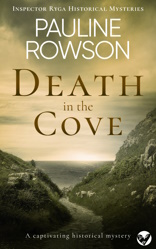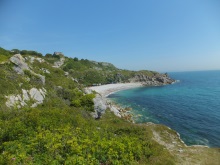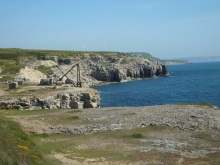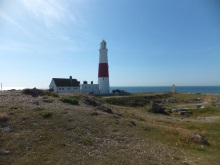
DEATH IN THE COVE is set in 1950 England, still reeling from the aftermath of war with austerity and rationing still in place, and many fractured lives as a result of five years of war. It is the first in the Inspector Ryga historical mystery series of which there are five and I am currently writing number six (2025).
 In DEATH IN THE COVE, Inspector Ryga, of Scotland Yard, is on his first solo investigation outside of London since his promotion. He's sent to the Island of Portland in Dorset to investigate the murder of a man, wearing a pin striped suit, found in an isolated cove, called Church Ope Cove.
In DEATH IN THE COVE, Inspector Ryga, of Scotland Yard, is on his first solo investigation outside of London since his promotion. He's sent to the Island of Portland in Dorset to investigate the murder of a man, wearing a pin striped suit, found in an isolated cove, called Church Ope Cove.
I first visited the Island of Portland in Dorset (4 miles long by 1.7 miles wide, jutting out into the English Channel on the South Coast of England) while researching for one of my Art Marvik, mystery thrillers and fell in love with it. It’s stunning and rugged coastal path, its quarry scarred landscape and hidden coves both inspired and captivated me.
I also have a bit of a thing about islands, after all I live on one (Hayling Island) and was born on one (Portsmouth) albeit both with land access. But then Portland connects with the mainland of Weymouth by road and in 1950 it was also joined by rail and ferry. The other island I visit regularly, and which is featured in both my Inspector Andy Horton Solent Murder Mysteries and the Art Marvik mystery thrillers, is the Isle of Wight with no road access (or fixed link) as islanders call it. Therefore a ‘real’ island. But to return to Portland.
 I thought Portland a good setting for my first 1950 set novel because in the 1950s the famous stone quarries were still operating. The white Portland stone had been used on the construction of many renowned buildings, St Paul’s Cathedral and Buckingham Palace among them, as well as in the building of the large breakwaters arching into the sea protecting Portland Harbour and the naval dockyard, the latter also still in operation in 1950.
I thought Portland a good setting for my first 1950 set novel because in the 1950s the famous stone quarries were still operating. The white Portland stone had been used on the construction of many renowned buildings, St Paul’s Cathedral and Buckingham Palace among them, as well as in the building of the large breakwaters arching into the sea protecting Portland Harbour and the naval dockyard, the latter also still in operation in 1950.
There was also a railway line in 1950 on to the island. The station closed to passengers in 1952, although regular freight kept the line in use until 1965. The platforms and canopies survived until the mid-1970s when they were demolished. In addition there was a prison, which features in the novel.
 Portland also has a remarkable lighthouse out on Portland Bill a rather windswept place, indeed my mother who was stationed on Portland Bill in the ATS during WW2 used to tell me how bleak it was. Portland Bill (the lighthouse) became a popular tourist destination after the first tarred road was laid in 1922 and during the 1930s a car park was also laid, while beach huts and cafes began to appear. Visitors to the lighthouse were welcomed, and in DEATH IN THE COVE Inspector Ryga visits the lighthouse where the head lighthouse keeper takes him up the lantern room.
Portland also has a remarkable lighthouse out on Portland Bill a rather windswept place, indeed my mother who was stationed on Portland Bill in the ATS during WW2 used to tell me how bleak it was. Portland Bill (the lighthouse) became a popular tourist destination after the first tarred road was laid in 1922 and during the 1930s a car park was also laid, while beach huts and cafes began to appear. Visitors to the lighthouse were welcomed, and in DEATH IN THE COVE Inspector Ryga visits the lighthouse where the head lighthouse keeper takes him up the lantern room.
There was a police station, court room and police houses on the island, along with many shops, some pubs and hotels, not forgetting the naval base.
This is 1950, no dashing about in police cars, no mobile phones, no computer databases, just good solid police work!
 A dead man is found by former war photographer Eva Paisley in a secluded bay on Portland Island. The victim was stabbed in the neck with a narrow-bladed knife.
A dead man is found by former war photographer Eva Paisley in a secluded bay on Portland Island. The victim was stabbed in the neck with a narrow-bladed knife.
Inspector Alun Ryga is called from Scotland Yard to investigate. But no one in the local community seems to know who the victim is.
The man appears to have been a labourer, but he is found dressed in a tailored pinstriped suit, silk underwear, handmade shoes and rare pink-diamond cufflinks. Something about him doesn’t add up . . .
Ryga quickly establishes a good working relationship with Eva Paisley. But the local police warn Ryga not to trust her.
It’s Ryga’s first solo investigation outside of London. He’s keen to prove his worth. But will it cost him his life?
Also available as an audio book.
See where the Inspector Ryga Historical Mysteries are set.
Pauline Rowson lives on the South Coast of England and is the best selling author of many crime novels, published by Joffe Books. Her popular crime novels include the DI Andy Horton Solent Murder Mystery series, the Art Marvik mystery thrillers and the 1950s set Inspector Ryga mysteries. Subscribe to her newsletter for all the latest books news.